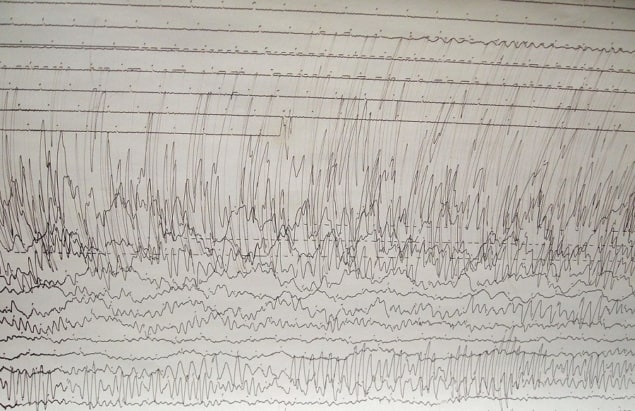
Disturbances in the Earth’s gravitational field caused by the 2011 Tohoku earthquake have been spotted in data recorded at the time by a network of seismometers spread throughout East Asia. The signal was identified by Martin Vallée and collaborators at Sorbonne Paris Cité and Commissariat à l’Energie Atomique et aux Energies Alternatives in France, and California Institute of Technology in the US. The analysis represents a faster, more accurate way than conventional methods of estimating the magnitude of large earthquakes.
Arrival times
Usually, the first physical indication of a distant earthquake is received in the form of elastic P-waves, which travel from the rupture site to the seismometer along arc-shaped paths through the crust and upper mantle. These pressure waves typically propagate at 6–10 km/s, meaning that for seismic stations more than 1000 km from the epicentre, several minutes can elapse between the earthquake and the arrival of the first direct seismic signal.
Large earthquakes can rearrange the Earth’s mass in such a way as to be detectable more immediately in perturbations to the gravitational field, however. As P-waves spread out from the ruptured fault, the solid medium is alternately squeezed and stretched, causing transient changes in rock density. Far beyond the primary seismic wavefront, these gravitational effects can trigger secondary seismic waves that can be picked up by seismometers before the direct waves arrive.
The ground accelerations caused by the gravitationally induced seismic waves in the data studied by Vallée and colleagues were on the order of 1–2 nm/s2 – smaller than the subsequent P-waves by a factor of more than 105. But it was not only the size of the disturbance that made its detection challenging. In the earliest moments after the fault slipped, the direct and induced effects of the gravitational perturbation cancelled out, and an identifiable signal only became apparent about 60 seconds after the event. This meant that the gravitational effect was most easily observable in the traces from stations located between 1000 and 1500 km from the epicentre, where the P-wave delay was long enough for the signal to emerge before being overwhelmed.
Minimum magnitude
The researchers simulated the effects of earthquakes of different sizes on the data, and found that the immediate gravitational signal recorded by stations about 1300 km from the epicentre set a lower limit of magnitude 9 for the Tohoku event. At the time, however, the difficulty of judging magnitude based on the instrumental peak amplitudes measured at nearby stations meant that the size of the earthquake was underestimated.
The research is published in Science
Disturbances in the Earth’s gravitational field caused by the 2011 Tohoku earthquake have been spotted in data recorded at the time by a network of seismometers spread throughout East Asia. The signal was identified by Martin Vallée and collaborators at Sorbonne Paris Cité and Commissariat à l’Energie Atomique et aux Energies Alternatives in France, and California Institute of Technology in the US. The analysis represents a faster, more accurate way than conventional methods of estimating the magnitude of large earthquakes.
Arrival times
Usually, the first physical indication of a distant earthquake is received in the form of elastic P-waves, which travel from the rupture site to the seismometer along arc-shaped paths through the crust and upper mantle. These pressure waves typically propagate at 6–10 km/s, meaning that for seismic stations more than 1000 km from the epicentre, several minutes can elapse between the earthquake and the arrival of the first direct seismic signal.
Large earthquakes can rearrange the Earth’s mass in such a way as to be detectable more immediately in perturbations to the gravitational field, however. As P-waves spread out from the ruptured fault, the solid medium is alternately squeezed and stretched, causing transient changes in rock density. Far beyond the primary seismic wavefront, these gravitational effects can trigger secondary seismic waves that can be picked up by seismometers before the direct waves arrive.
The ground accelerations caused by the gravitationally induced seismic waves in the data studied by Vallée and colleagues were on the order of 1–2 nm/s2 – smaller than the subsequent P-waves by a factor of more than 105. But it was not only the size of the disturbance that made its detection challenging. In the earliest moments after the fault slipped, the direct and induced effects of the gravitational perturbation cancelled out, and an identifiable signal only became apparent about 60 seconds after the event. This meant that the gravitational effect was most easily observable in the traces from stations located between 1000 and 1500 km from the epicentre, where the P-wave delay was long enough for the signal to emerge before being overwhelmed.
Minimum magnitude
The researchers simulated the effects of earthquakes of different sizes on the data, and found that the immediate gravitational signal recorded by stations about 1300 km from the epicentre set a lower limit of magnitude 9 for the Tohoku event. At the time, however, the difficulty of judging magnitude based on the instrumental peak amplitudes measured at nearby stations meant that the size of the earthquake was underestimated.
The research is published in Science



